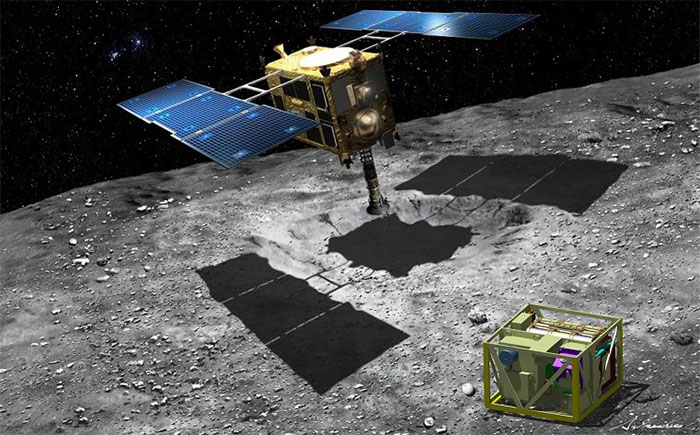The asteroid discovery robot is hundreds of millions of kilometers from Earth
On October 3, Japan brought Mascot - a new observation robot - onto the Ryugu asteroid , located about 300 million kilometers from Earth in the mission to shed light on the formation of the solar system as well as its origin. life on Earth.
The Japan Aerospace Research Agency (JAXA) said Mascot is a landing robot shaped like a small box weighing 10 kg, developed by German and French aerospace agencies. Mascot was removed as planned 51m away.
According to the plan, Mascot will capture images, check the temperature and soil on the surface of the Ryugu asteroid by using 4 observation devices including camera and microscope.

Hayabusa2 unmanned space exploration ship.
Mascot runs on battery so it can only be operated within 16 hours before the power runs out. Unlike other land-based robots that use solar energy, Mascot can operate at night.
According to previous observations, the Ryugu asteroid is a diamond-shaped asteroid, estimated to be about 900 meters in diameter, orbiting the Sun for a period of 16 months, spinning near the orbits of Earth and Mars.
This type-C (carbon) asteroid is thought to contain a large amount of water and organic matter, which are essential for life. Scientists hope that soil samples collected from this asteroid will shed light on the cause of life on Earth.
Hayabusa2 was launched from Tanegashima Space Center in Kagoshima Prefecture, southwestern Japan, in December 2014 with the mission to travel to Ryugu asteroid to collect rock samples. Hayabusa2 has a smooth journey, overcoming 3.2 million km over 3 years and has adjusted its trajectory from the beginning of June before reaching the target of the Ryugu asteroid. The cost of this research project is 30 billion yen (equivalent to 274 million USD).
Improved compared to the previous version of Hayabusa, which weighs about 600 kg and is about the same size as a large refrigerator, Hayabusa2 consists of more durable ion engines that add 25% thrust and an antenna that has been upgraded to transmit more data to the Earth.
The 'sunbae ' Hayabusa only collects specimens from the asteroid surface, while Hayabusa2 will use a metal press to dig under the planet's surface to access matter unaffected by the asteroid. Sun radiation as well as other objects.
- The asteroid is about to fly closest to Earth in 115 years
- The asteroid more than 4km is about to cross the Earth
- Japan is about to drop the last robot on the asteroid
- Japanese spacecraft dropped the last robot on the asteroid
- A 2,000-meter asteroid could crash into Earth in the future
- This afternoon, an asteroid will fly over the Earth
- Asteroid 800,000km2 fly near the Earth
- An asteroid has just crossed the Earth
- 2012 Asteroid BX34 almost collided with the Earth
- The biggest asteroid in the year is rushing towards Earth
- Video: The 7m asteroid is about to rush through the Earth
- The terrifying asteroid is about to hover near Earth
 Van Allen's belt and evidence that the Apollo 11 mission to the Moon was myth
Van Allen's belt and evidence that the Apollo 11 mission to the Moon was myth The levels of civilization in the universe (Kardashev scale)
The levels of civilization in the universe (Kardashev scale) Today Mars, the sun and the Earth are aligned
Today Mars, the sun and the Earth are aligned The Amazon owner announced a secret plan to build a space base for thousands of people
The Amazon owner announced a secret plan to build a space base for thousands of people